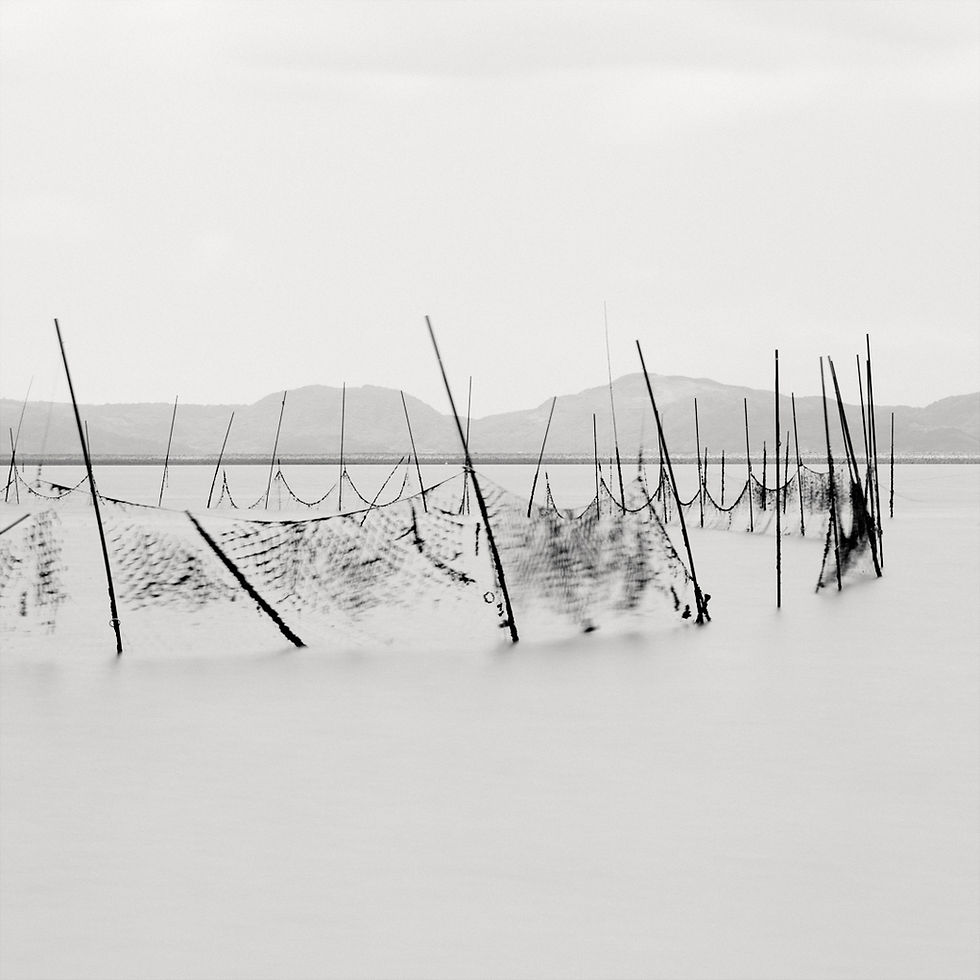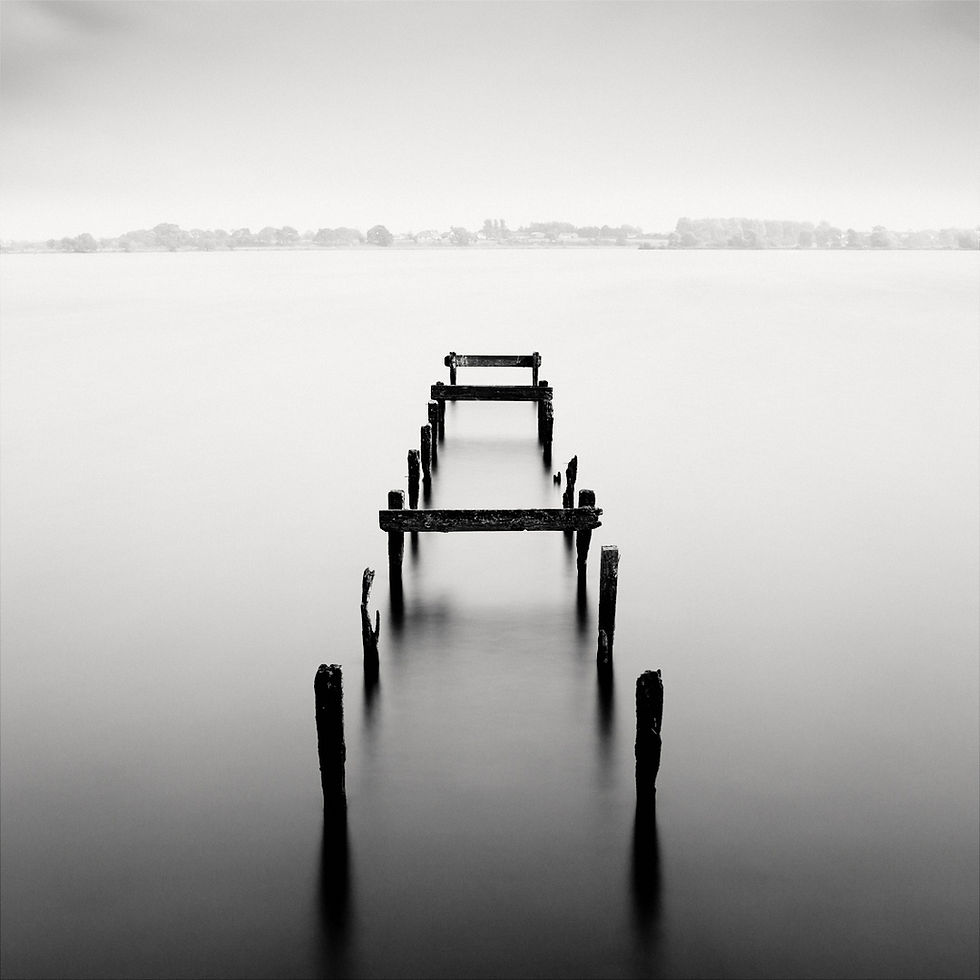Landscapes and Minimalism: A Tribute to Abandoned Structures
- Olivier

- Feb 18, 2023
- 7 min read
Updated: Mar 29, 2025
Minimalist photography, in its pursuit of simplicity and sobriety, finds a particular resonance when it focuses on abandoned structures. These forgotten architectures, eroded by time, stand as silent monuments, evocative of our industrial and cultural past.

In a world where incessant progress shapes our environment, abandoned structures become sentinels of the past, reminding us of bygone eras and the inevitable cycles of nature.
Through this article, I wish to focus on a theme that has been the subject of numerous questions from my clients and visitors to my exhibitions: the importance that abandoned objects in the landscape or on the water's surface represent to me. What inspires me in these seemingly insignificant constructions that I attempt to highlight in my photographs? What place or value do I wish to assign to them? And so on.
Furthermore, to answer these questions, here are 7 philosophical principles that best describe my work and the approach it embodies.

1. The Valorization of Abandonment
Minimalist photography of abandoned structures is part of both an artistic and philosophical approach. It does not merely document decay but seeks to transcend the ruin to extract a form of austere and contemplative beauty.
Long exposure, as a technical tool, amplifies this search by introducing a temporal dimension that enriches the interpretation of the images. These become spaces for reflection on time, memory, and our relationship to the built world. Abandoned structures, through the lens of the minimalist photographer, thus reveal themselves not as relics of the past but as artworks in their own right, poignant tributes to human perseverance in the face of time's inexorability.
2. A Quest for Meaning
Photographic minimalism is an artistic approach characterized by the simplification of composition, the use of sober colors, often in black and white, and the search for a visual balance based on a few elements. For me, minimalist photography is a unique means of expression that allows capturing and valorizing the melancholic essence or austere beauty of these forgotten relics.
Far from being a limitation, this approach opens up a vast field of expression where every detail acquires meaning. In the context of abandoned structures, minimalism becomes a way to highlight their streamlined aesthetics and primary function by eliminating the superfluous to focus on form, texture, and the object's interaction with its environment.

3. Mirrors of Time
Abandoned buildings, whether industrial, residential, or institutional, tell stories. Behind their apparent decay lie narratives of prosperity and decline, innovation, and obsolescence.
Through a lens that prioritizes the simplification of composition, the contrast of textures, and visual balance, these obsolete structures invite reflection on the passage of time, collective memory, and our relationship to the built world.
In minimalist photography, these structures are apprehended not only as aesthetic subjects but also as poignant symbols of human temporality and the ephemeral nature of our constructions. The minimalist approach, with its ability to isolate the subject, highlights the silent dignity and melancholy of these spaces, transforming a ruin into an object of contemplation.
4. A Temporal Dimension
The technique of long exposure is particularly suited to highlighting abandoned structures. By allowing for an extended exposure, it captures not just light but also time, creating images where movement blends into an impression of permanence and tranquility.
The sky and water become smooth, plants sway, while the structure, stationary, stands out clearly. This juxtaposition between the dynamism of the natural environment and the stasis of the constructed object reinforces the contrast between the ephemeral passage of time and the relative permanence of human creations.

5. Memory and Oblivion
Photographing abandoned structures is also to question their place in collective memory. The minimalist approach, by simplifying the frame, invites meditation on what remains when everything else has been carried away by time. The power of black and white then reveals itself to be a formidable tool of expression (see below).
These images thus become temporal capsules, bridges between the past and the present, prompting the viewer to reflect on the fragility of human existence and the relentless force of time. The ruin, in its solitude, evokes the notion of absence, but also that of resilience, testifying to the ability of structures to endure beyond their initial utility.
6. The Added Value of Water
Incorporating water into the photography of abandoned structures adds another significant dimension both aesthetically and emotionally. Water, with its intrinsic qualities of movement and reflection, enriches the composition and strengthens the message conveyed by the images, especially when captured in long exposures.
Aesthetic Dimension
Calm water creates perfect reflections of structures. It promotes a symmetry that balances the composition and adds visual depth. These reflections then transform the perception of a structure, giving it an almost surreal dimension.
By using long exposures, moving water transforms into a smooth and ethereal surface that contrasts with the often rough and detailed textures of abandoned remains. This contrasted opposition creates a fascinating visual balance between the softness of the water and the harshness of the ruin.

Emotional Dimension
The presence of water induces a feeling of peace and tranquility in the viewer. In the context of abandoned structures, it immediately prompts a melancholic reflection on the passage of time, offering a unique contemplative experience of the landscape.
Water is also often associated with life and renewal. Its juxtaposition with dilapidated structures highlights the contrast between growth and decline, between permanence and ephemeral, evoking the coexistence of destruction and rebirth in nature.

Narrative Value
Lastly, water adds a layer of context to the story of the photographed structures. For example, a disused building in the middle of a lake or the sea immediately initiates reflection on its past role in a community, on the human activities that took place there, and on the impact of these activities on the natural environment.

Water can thus serve as a powerful metaphor in visual storytelling, symbolizing the passage of time, fading memory, or purification and redemption. These elements reinforce the unique character of abandoned structures. They invite a richer and more profound interpretation of the images.
7. The Evocative Power of Black and White
When it comes to capturing the essence of abandoned structures, the choice of black and white in photography serves as a powerful vehicle. This choice, by its very nature, reinforces their timeless message and transcends mere visual representation to become a commentary on history and collective memory.
Timelessness and Abstraction
Black and white eliminates the distraction of colors, reducing the image to its basic forms, textures, and contrasts. This abstraction distances the structures from their immediate and contemporary context, placing them in a sort of temporal no man's land.
The result is a timelessness that invites the viewer to a deeper reflection on the nature and history of these constructions. Without the temporal cues provided by colors, these structures seem to belong to any era. Black and white thus underscores their eternal character while highlighting their physical decline and gradual oblivion.

Contrast and Dramatization
Black and white enhances the play of light and shadow, thus dramatizing the appearance of abandoned structures. It amplifies the message while highlighting their melancholic beauty and solitude. The strong contrasts, which I particularly appreciate, bring out the eroded texture of the materials and the broken silhouettes against the sky or horizon. This visual treatment reinforces the message of these places as silent witnesses to a bygone past, increasing the emotional impact on the viewer.

Symbolism and Memory
Black and white carries a historical, symbolic, and emotional weight. Associated with early photographs and documentary archives, it evokes a direct connection with the past. Using black and white to photograph abandoned structures thus strengthens this link between the present and the past, acting as a reminder of their historical and cultural importance.
This approach symbolizes the duty of memory towards these forgotten places, presenting them not only as aesthetic curiosities but also as fragments of history to be preserved and immortalized.

Universal Message
Finally, black and white contributes to the universality of the message conveyed by these abandoned structures. By shedding colors, which can be perceived in a subjective manner, the black and white image aims for a more objective emotional resonance, touching on universal themes such as the passage of time, loss, and nostalgia. This allows the structures to speak not only of their own past but also to suggest a broader reflection on humanity, progress, and oblivion.
In conclusion, black and white does not merely document abandoned structures in their environment. It transforms them into powerful symbols of our relationship with time, history, and memory. Through its abstraction, contrast, and symbolism, it invites deeper and more universal contemplation, making these images a poignant call for the conservation of our tangible and intangible heritage.











